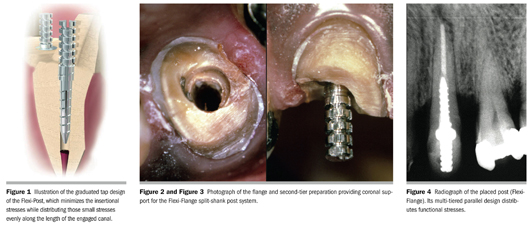The Split Shank Post: The Best Design For Long-Term Success
When we think of the rationale for placing a post, stabilizing the overlying restoration is our primary goal. If sufficient coronal dentin exists, most of us know that a post is not necessary for that stability. In fact, removal of coronal dentin to place a post is counterproductive because a greater amount of support is lost than would be gained from the post placement.
So, for the most part, we can limit our discussion to the placement of posts where minimal coronal dentin exists, a condition that places maximum stress on the post’s long-term stability. To achieve adequate stability, the post must have high retention, gain that retention without insertional stresses, and then have a configuration that distributes functional stresses as evenly as possible. Furthermore, a desirable trait is to have the post be at least as stiff as the tooth into which it is embedded. If the post is more flexible than the root, it may bend more under function, potentially creating gaps along the bonded composite dentin interface that could lead to a loss of marginal integrity with a greater incidence of secondary decay occurring.
A metal post is as stiff as the tooth into which it is embedded. Metal is superior to ceramic because, while stiffer than tooth when equal in a cross-sectional area, it will bend similarly to tooth structure in the narrow dimensions it has as a post. A ceramic post, on the other hand, will bend far less than the tooth despite the thinner cross-sectional area. Compatibility in bending between the post and the root is essential for long-term success.
A basic component of stability is excellent retention. Any post held into place via adhesive cementation has a maximum upper value of retention that does not exceed 90 pounds simply because that is the upper limit of the cohesive strength of the cement. For a post to have higher retention, it must engage the walls of the canal, which means it must have a thread. The thought of a thread may bring gasps from dentists who equate threads with excessive insertional stresses. Yet, a thread is perfectly acceptable if it is also combined with a split-shank design post. The split shank turns the post into a graduated tap which allows the thread to engage the dentin, creating and deepening the grooves into the dentin in a gradual fashion that minimizes the insertional stresses while distributing those small stresses evenly along the length of the engaged canal (Figure 1). An even distribution of insertional stresses can only occur because of the split-shank design. The same threads on a solid-shank post would concentrate the stresses around the lead thread, possibly causing a fracture at the point of the most apical placement of the post.
The second beneficial fact is that threads along the length of a post are good distributors of functional stresses provided the insertional stresses were not excessive. We can take advantage of the stress-distributing capabilities of the threads because the insertional stresses were reduced and modified by the split-shank design of the post. The split-shank post maximizes retention while producing no more insertional stresses than a passive post. Of equal if not more importance, the thread now distributes functional stresses evenly along the length of the embedded shank.
Some secondary features of the split-shank post include their multi-tiered parallel design. The wider coronal tiers of the post produce a more intimate fit of the post to the canal with minimal sacrifice of internal tooth structure. A good coronal fit prevents the breakdown of coronal cement because the post is well supported circumferentially by solid dentin (Figure 2 and Figure 3). In addition, the multi-tiered parallel design translates functional forces into horizontal and vertical vectors of force. The vertical forces are resisted by the compressive strength of dentin, which is quite high, leaving a smaller percentage of the functional stresses resisted by the significantly weaker tensile strength of dentin (Figure 4). If the post were tapered, all of the functional forces would be translated into tensile stresses, increasing the incidence of vertical fracture.
For more information, contact:
Essential Dental Systems
Phone: 201-487-9090
Web: www.edsdental.com
Disclaimer
The preceding material was provided by the manufacturer. The statements and opinions contained therein are solely those of the manufacturer and not of the editors, publisher, or the Editorial Board of Inside Dentistry. The preceding is not a warranty, endorsement, or approval for the aforementioned products or services or their effectiveness, quality, or safety on the part of Inside Dentistry or AEGIS Communications. The publisher disclaims responsibility for any injury to persons or property resulting from any ideas or products referred to in the preceding material.






